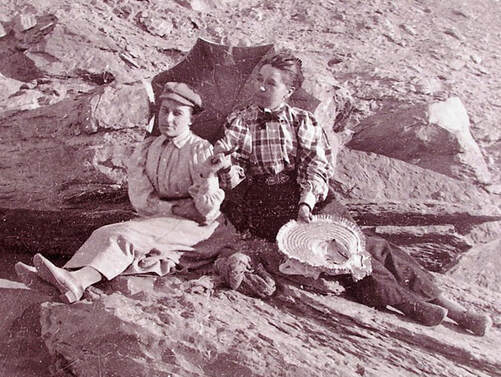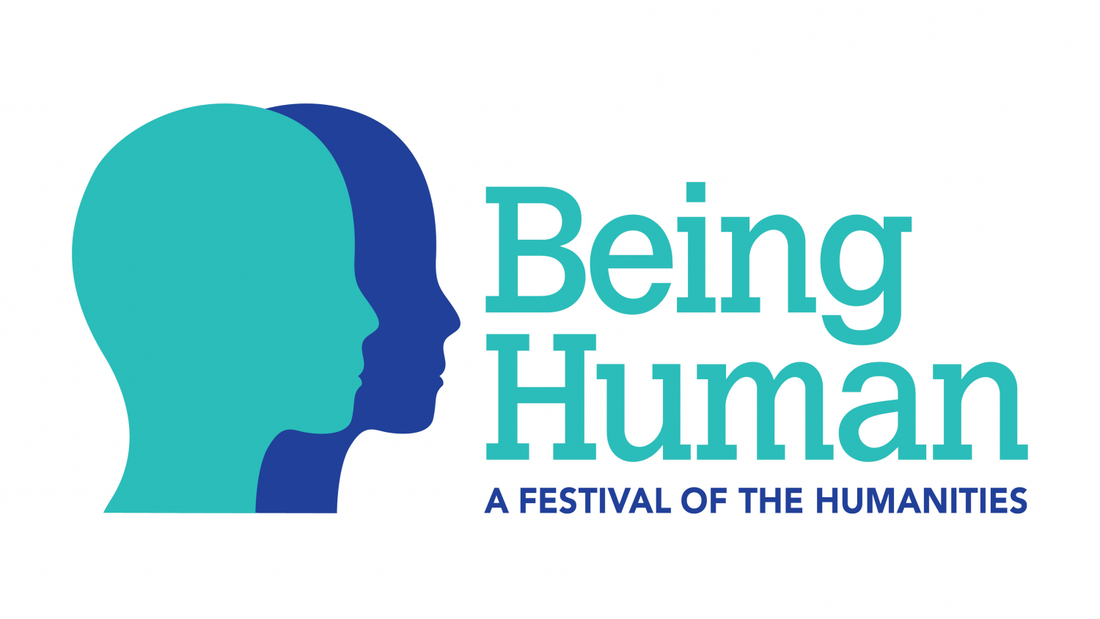ANNIE QUIBELL (1851-1927)
 Annie Quibell (right).
Annie Quibell (right).
Annie Abernethie Quibell nee Pirie was the daughter of Aberdeen academic William Robinson Pirie. Born on 15th of December 1851 at 13 Bon Accord Square. She studied as an artist and had extensive training and experience including exhibiting in the Royal Scottish Academy, working mainly in pastels an oil paints.
Annie moved to London to further her fascination with ancient Egypt. There she became one of Flinders Petrie’s early students with her artist colleague Rosalind Piaget. Annie travelled to Egypt to work as a copyist for Petrie at Saqqara in 1895, and made drawings and sketches of the reliefs and the sites themselves. During the season in Egypt Annie met Petrie’s assistant James Edward Quibell. They worked together on three digs at Thebes at Ramesseum, El Kab and the Hierakonpolis. It was during one of these digs that Annie fell in love with Edward while they were nursing each other through a bout of food poisoning. This was common on site for many reasons one of them being burying food in the sand that then became contaminated.
They married at Sunnybank house in Aberdeen on the 6th of September 1900. Annie’s husband was then the inspector of Antiquities in Egypt, so the couple moved there. Although she held no official position, Annie di did most of the work work in documenting and protecting ant antiquities and sites alongside her husband ad colleagues. Life on site suited Annie from the outset. In her own words “of all the different dwelling places, give me, for choice, if for not too long a time, a good tomb. It is sometimes objected to, by those unacquainted with the merits of a tomb as a place to live in, on the ground that, as one is sure to spend a great deal of time there eventually, it is a mistake to begin too soon. But it has so many recommendations that one gets over that point of view. It is warm in the cold weather, fairly cool when it is hot; it is silent and still; the wind does not blow ones possessions about, it generally pretty well lit by a door and sometimes a window. I am not speaking of the funeral vault…but of the tomb chapel above. In Upper Egypt these are generally hollowed out of the rock, like caves, and a long row of them together can accommodate quite a large household. The shafts at the bottom of which the real burial is, sometimes still gape in the floor and one has to be careful not to fall in but this is almost the only drawback”
In 1904 Annie and her husband contributed to the Egyptian exhibition for the world’s fair in St Louis. Annie was credited with most of the work in the display's instillation. The display included three life-size recreated scenes of Ancient Egyptian life. After this she spent a year at Luxor helping to discover two tombs, she spent 8 years of hard work at Sakkara during which Annie made most of the drawings both in line and colour of the site and wall reliefs. These were published in her husband’s reports of the excavations, as well as creating the object illustrations for the exhibition.
Her illustrations include objects found at Hierakonpolis which are now in the National Museums Scotland collection, and she was responsible for arranging the Egyptian gallery at the Marischall Museum at Aberdeen University. When Edward Quibell took over the keepership of the Cairo Museum in late 1913, Anne had less archaeological work to undertake. When the First World War started, Annie devoted her time to canteen work and the organising of outings for invalid soldiers. In later life Annie published 5 books aimed at everyone. A Wayfarer in Egypt, Some Notes on Egyptian History and Art, The Pyramids of Giza, The Tomb of Sakkara, and a Guide to the Cairo Museum.
Annie was interested in many forms of social work, and she was president of the Cairo YWCA. It says in her obituary “It is largely due to her practical sympathy and administrative genius that this body has of recent years accomplished such excellent work”. She died of leukaemia 1927 at the age of 65. She is buried in the Old Machar churchyard in Old Aberdeen. Annie left a legacy, particularly through her illustrations, which are still used by researchers today.
Entry written by Amy Thomson.
Annie moved to London to further her fascination with ancient Egypt. There she became one of Flinders Petrie’s early students with her artist colleague Rosalind Piaget. Annie travelled to Egypt to work as a copyist for Petrie at Saqqara in 1895, and made drawings and sketches of the reliefs and the sites themselves. During the season in Egypt Annie met Petrie’s assistant James Edward Quibell. They worked together on three digs at Thebes at Ramesseum, El Kab and the Hierakonpolis. It was during one of these digs that Annie fell in love with Edward while they were nursing each other through a bout of food poisoning. This was common on site for many reasons one of them being burying food in the sand that then became contaminated.
They married at Sunnybank house in Aberdeen on the 6th of September 1900. Annie’s husband was then the inspector of Antiquities in Egypt, so the couple moved there. Although she held no official position, Annie di did most of the work work in documenting and protecting ant antiquities and sites alongside her husband ad colleagues. Life on site suited Annie from the outset. In her own words “of all the different dwelling places, give me, for choice, if for not too long a time, a good tomb. It is sometimes objected to, by those unacquainted with the merits of a tomb as a place to live in, on the ground that, as one is sure to spend a great deal of time there eventually, it is a mistake to begin too soon. But it has so many recommendations that one gets over that point of view. It is warm in the cold weather, fairly cool when it is hot; it is silent and still; the wind does not blow ones possessions about, it generally pretty well lit by a door and sometimes a window. I am not speaking of the funeral vault…but of the tomb chapel above. In Upper Egypt these are generally hollowed out of the rock, like caves, and a long row of them together can accommodate quite a large household. The shafts at the bottom of which the real burial is, sometimes still gape in the floor and one has to be careful not to fall in but this is almost the only drawback”
In 1904 Annie and her husband contributed to the Egyptian exhibition for the world’s fair in St Louis. Annie was credited with most of the work in the display's instillation. The display included three life-size recreated scenes of Ancient Egyptian life. After this she spent a year at Luxor helping to discover two tombs, she spent 8 years of hard work at Sakkara during which Annie made most of the drawings both in line and colour of the site and wall reliefs. These were published in her husband’s reports of the excavations, as well as creating the object illustrations for the exhibition.
Her illustrations include objects found at Hierakonpolis which are now in the National Museums Scotland collection, and she was responsible for arranging the Egyptian gallery at the Marischall Museum at Aberdeen University. When Edward Quibell took over the keepership of the Cairo Museum in late 1913, Anne had less archaeological work to undertake. When the First World War started, Annie devoted her time to canteen work and the organising of outings for invalid soldiers. In later life Annie published 5 books aimed at everyone. A Wayfarer in Egypt, Some Notes on Egyptian History and Art, The Pyramids of Giza, The Tomb of Sakkara, and a Guide to the Cairo Museum.
Annie was interested in many forms of social work, and she was president of the Cairo YWCA. It says in her obituary “It is largely due to her practical sympathy and administrative genius that this body has of recent years accomplished such excellent work”. She died of leukaemia 1927 at the age of 65. She is buried in the Old Machar churchyard in Old Aberdeen. Annie left a legacy, particularly through her illustrations, which are still used by researchers today.
Entry written by Amy Thomson.



